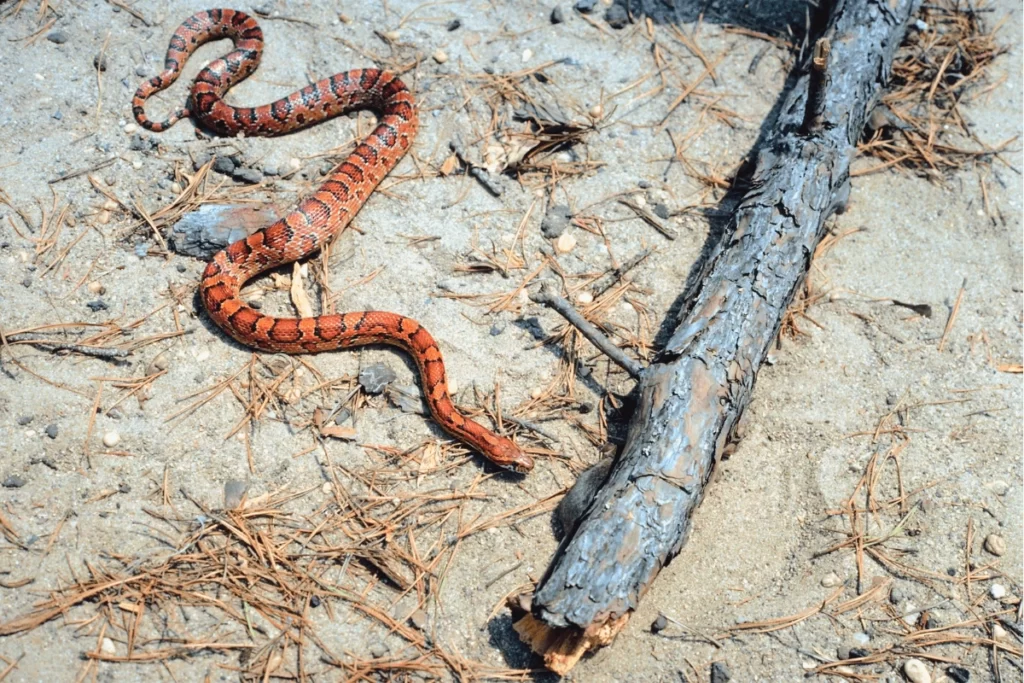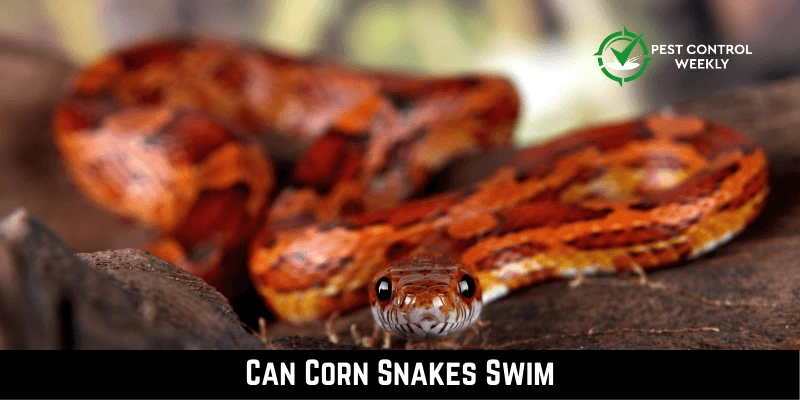Corn snakes are one of the most common types of pet snakes. Their unique colors, calm nature, and easy care needs make them great pets for new and experienced herpetologists. One of the most often asked questions about caring for corn snakes is, can corn snakes swim?
Yes, corn snakes can swim. People usually think of animals that live in water and are not able to swim. But corn snakes, which live on land most of the time, can swim quite well when they need to.
In this article, let’s take a more in-depth look at the corn snake’s swimming ability. Its attraction (or lack thereof) for water and what this means for you as a corn snake.
Habitat of Corn Snakes
Corn snakes (Pantherophis Guttatus) live in a diverse natural environment in the southeastern United States. Most of the time, they live in overgrown fields, forest openings, trees, and abandoned or rarely-used houses or barns. Most of the time, these species choose their habitats based on where they can find rodents to eat.
Food is abundant in their ecosystem because of the abundance of pine forests, scrub brush, and deciduous hardwoods. The region’s subtropical climate suits its life cycle, providing enough warmth and humidity for growth and reproduction. These snakes are also quite versatile, surviving in a wide range of environments, from the lowlands near the coast to the high, rocky highlands inland.
Natural Swimming Behavior of Corn Snakes

Corn snakes can swim quite well in the wild. They aren’t fish or amphibians or anything, but they can swim when they have to. When they go into rivers, lakes, or ponds, they use a rolling side-to-side movement to move forward, and they keep their heads high above the water to breathe. This ability to change can help animals stay safe from predators, find food, or cross water during territorial movements.
However, these snakes rarely swim. Corn snakes can survive in water but are far more adapted to their terrestrial habitats for hunting and other survival needs. Their ability to swim is another example of their strength and flexibility.
How Do Corn Snakes Swim?
Corn snakes use an amazing swimming technique that uses their undulating structure. They use a sinuous undulating motion to move ahead in the water, similar to how they move on land. The snake moves in an S-shaped undulation on the side, pushing itself forward against the water. Their powerful muscles and long, sleek body allow them to maintain precise control in the water.
Corn snakes can breathe and see above water at the same time because they maintain their heads above water while swimming. However, because they don’t swim very often, they might look less graceful in the water than water snakes or sea snakes, which are native to the water.
Are Corn Snakes Attracted To Water?
No, corn snakes are not attracted to water. Corn snakes can swim, but they have little interest in doing so. They mainly inhabit grasslands, forests, and even suburban areas because of their terrestrial and arboreal lifestyles. They may do so when hunting for food, avoiding danger, or crossing waterways on territorial journeys.
Water sources may attract prey, making them good hunting spots. But this shouldn’t be seen as a natural draw to water. The snakes show that they can adjust to different situations and don’t have a special liking for water.
Can Corn Snakes Breathe in Water?
No, corn snakes cannot breathe underwater. Corn snakes, like all other terrestrial reptiles, need oxygen to live but lack gills to obtain oxygen from water. They breathe through their lungs, so they have to keep their heads above water while swimming. This doesn’t mean they can’t go totally underwater. They can, but only for short periods, like how humans can hold their breath underwater.
During these times, they can keep water out of their lungs by closing a passage in their windpipe called the glottis. After coming to the surface again, they can reopen their glottis and breathe normally. However, prolonged underwater stays can stress corn snakes or possibly kill them.
Do Corn Snakes Need Bathing?
No, corn snakes do not need bathing. Corn snakes, unlike our mammalian buddies, can take care of their personal hygiene and don’t need regular baths. Ectothermic organisms like these don’t have sweat glands and don’t secrete body oils. So they don’t have to clean up themself the way most animals do. In some cases, a dip may be necessary.
Soaking the snake in warm water can help remove sticky things from its scales. Similarly, a warm bath may help solve the problem of cloacal impaction. However, keep in mind that bathing these reptiles too often may cause them to stress or disrupt the normal skin microbiome.
Does Water Help Corn Snakes Shed Their Skin?
Yes, water can help corn snakes shed their skin. During ecdysis, the process of shedding skin, water can be a very helpful tool for a corn snake. The ideal humidity level in their habitat acts as a trigger in the shedding process. Helping the clean separation of the old skin from the new.
Dysecdysis occurs when a snake has problems shedding its skin, and a damp hide or light bath will usually help. However, dependence on soaking alone is not a good sign of a healthy ecosystem. The aim is to create conditions that promote healthy shedding on their own.
Can Corn Snakes Swim In The Wild?
Yes, corn snakes can swim in the wild. Even though corn snakes are land animals by nature. But they have the ability to swim and can do so if they need to in their natural environment. Their snake bodies let them move efficiently in the water with a swimming motion similar to their terrestrial movement. But most of the time, they only swim when they need to catch food, get away from predators, or get through wetlands.
Corn snakes don’t spend much time in the water since they find the earth and their tunnels to be more secure. So, in captivity, all they need is a good-sized water dish to use for drinking and taking baths.
Can Cornsnake Babies Swim?
Yes, baby corn snakes, can swim. Corn snakes are born with the natural ability to swim. This basic skill develops automatically as a means of survival, allowing the animal to move around in various habitats, including murky swamps. These baby snakes are extremely delicate and weaker swimmers than their bigger, stronger adult family members.
So, it is very important to be careful when bringing newborns to water in captivity. Any water should be small enough to keep the snakelet from going under, so it can slither through it instead of swimming.
How Long Can A Corn Snake Hold Its Breath Underwater?
Corn snakes are amazing animals with unique body structures. They aren’t fish or aquatic insects, but while underwater, they may stop their metabolism and hold their breath for a long time. It’s important to remember that this is a stress response and not something you do for fun.
These creatures that live on land don’t spend a lot of time underwater. And they don’t usually go into deep water in the wild. Their lungs are better suited to life on land. Thus, they shouldn’t be underwater for any length of time or be exposed to water in any other way than natural.
Is Swimming Good For Corn Snakes?
Although corn snakes can swim well, they are mainly land animals. They sometimes swim, but it’s not something they do often. Swimming can be a good way to get exercise and keep your mind active, and a short swim can help corn snakes to get rid of stuck sheds or messy substrates.
Creating a comfortable and satisfying terrestrial setting is more important than promoting the health and happiness of the swimmers. Overexposure to water also poses health risks by changing the skin’s thermoregulation and microbiota. Even though swimming isn’t always bad for corn snakes, it shouldn’t be the focus of their captive care.
Benefits Of Swimming For Corn Snakes
- Helps Maintain Hygiene: When corn snakes go for a swim, they can shed any dirt or sticky material that has been collected on their body.
- Facilitates Ecdysis: Corn snakes that are having difficulty with the shedding process may find that a relaxing swim helps. Ecdysis, the process by which dead skin is shed, might go more smoothly if the environment is moist.
- Stimulus and Exercise: Swimming is a unique way for corn snakes to move, and it gives them both exercise and mental excitement. They may benefit physically and emotionally from the change in routine.
- Help with Temperature Regulation: Water’s natural thermal qualities can help corn snakes control their body temperature. A cool swim could be very appealing during hot weather.
Risks Of Swimming For Corn Snakes
- Stress: Since corn snakes live on land, frequent or forced swimming could cause them too much stress, which could affect their health and attitude.
- Ding Risk: There is a big risk of dying when a snake swims, especially if the water isn’t deep enough or isn’t watched while in the water.
- Hypothermia Risk: Since snakes are ectothermic, they can get cold if the water temperature is too low or if they stay in the water for a long time.
- Damage to the Skin’s Microbiome: The snake’s skin microbiome can be thrown out of balance if it spends too much time in the water.
- Dangers of Excessive Moisture: Keeping corn snakes in a too-damp environment can lead to illnesses like blister disease, a frequent sickness among reptiles. Finding a happy medium between dehydration and illness is essential.
Conclusion
Corn snakes are unique animals, and their relationship with water, especially their ability to swim, is a complex topic. Even though these snakes live on land, they can get around in water if they have to, but they are most at ease on firm ground. Even though swimming is exciting, it should be relaxed in captivity.
Finally, as caretakers, we are responsible for creating conditions as similar to the animals’ natural environments as possible. Acknowledging and respecting the snake’s natural behaviors is important in maintaining an equilibrium between land and water.

